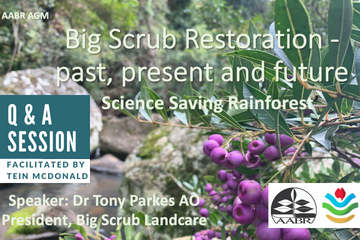Project Description
The following questions were posed to Dr Tony Parkes at the AABR AGM held 19/2/22.
00:25 Why don’t we value the Big scrub and when do you think it will change?
02:45 Is this work being done elsewhere in the world…The Science Saving Rainforests?
04:45 In the genome project are the species limited to those only in the Big Scrub?
05:45 How much threat is the subdivision of hobby farms?
07:20 Improving genetic diversity is an essential part of any project, how much of an example, how feasible is kind of project , what are the barriers to other groups taking up this kind of project?
ADDITIONAL QUESTIONS ANSWERED by Dr Robert Kooyman, one of Australia’s most eminent rainforest field and evolutionary ecologists.
Have there been a recorded / noticeable improvement in pollinator species and key fauna species from the areas you’ve worked on rehabilitating?
Pollinator species in rainforest are mostly small insects (small white flower syndrome; refer to Delmas et al. 2016). Surveys of insects have not been conducted as part of remnant monitoring.
Key fauna species such as Wompoo Fruit Dove, Rose-crowned Fruit Dove, and numerous other bird and flying mammal species (e.g., mircro- and macro-bats) are major beneficiaries of invasive vine control, improved tree health, maintenance of canopy trees and forest structure, and subsequent improved resource availability (e.g., fruit / nectar / insects etc).
Delmas C, Kooyman RM, Rossetto M. 2020. Evolutionary constraints and adaptation shape the size and colour of rainforest fruits and flowers at continental scale. Global Ecology and Biogeography 29: 830-841. DOI: 10.1111/geb.13065
____________________
Many native species appear capable, like weeds, to colonise new sites via seed dispersal (e.g. animal, wind, water), starting new populations with very low populations, hence (presumably) with very low genetic diversity. If that’s correct?
Early colonising rainforest species are mostly widely dispersed pioneers (and vines) which do behave somewhat like ‘invasive’ species (refer to Kooyman et al. 2013) and do naturally have lower genetic diversity than some other species. However, for continuing rainforest development to occur, mature phase species dispersal is required, and such species have genetic diversity that is more spatially structured. Thus they have more genetic diversity overall (e.g., Rossetto et al. 2015).
Kooyman, R.M., Zanne, A., Gallagher, R.V., Cornwell, W., Rossetto, M., O’Connor, P., Parkes, E.A., Catterall, C.F., Laffan, S.W. and Lusk, C.H. (2013) Effects of growth form and functional traits on response of woody plants to fragmentation of subtropical rain forest. Conservation Biology 27(6): 1468-1477.
Rossetto, M., Kooyman, R.M., Yap, J-Y.S., Laffan, S. 2015. From ratites to rats: the size of fleshy fruits shapes species distributions and continental rainforest assembly. Proceedings of the Royal Society Biology B 282: 20151998 (electronic)
______________________
While the issue of low genetic diversity within species is important, is there anything Tony could add (for this forum of bush regenerators) regarding which plant families, genera, etc. to indicate which species may be more prone to the threat of low genetic diversity? For example, many/most non-rhizomatous Cyperaceae spread quite easily. Many Proteaceae appear on the decline, with some exceptions, like Banksia integrifolia. I.e. probably no easy answer.
For this sort of talk the focus should be on later stage (mature phase) canopy and subcanopy trees, particularly (as an example) species with larger fruit and seed sizes (refer to REFS above).
______________________
We’re very concerned when we see EVEN 1 plant of a serious weed species, because it could spread. Then what’s the difference when we see ONLY1 plant of a native species?
Not sure what that means or what was said, but there is generally a vast difference between the capacity of weeds to reproduce and spread compared to native species. The reason weeds are a problem is because of predator and pathogen release and enhanced capacity to establish and proliferate. If native species had that capacity we would not be so concerned about weed competition.

